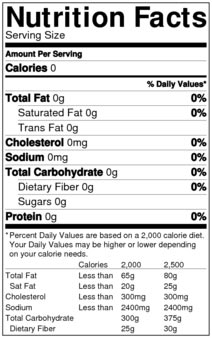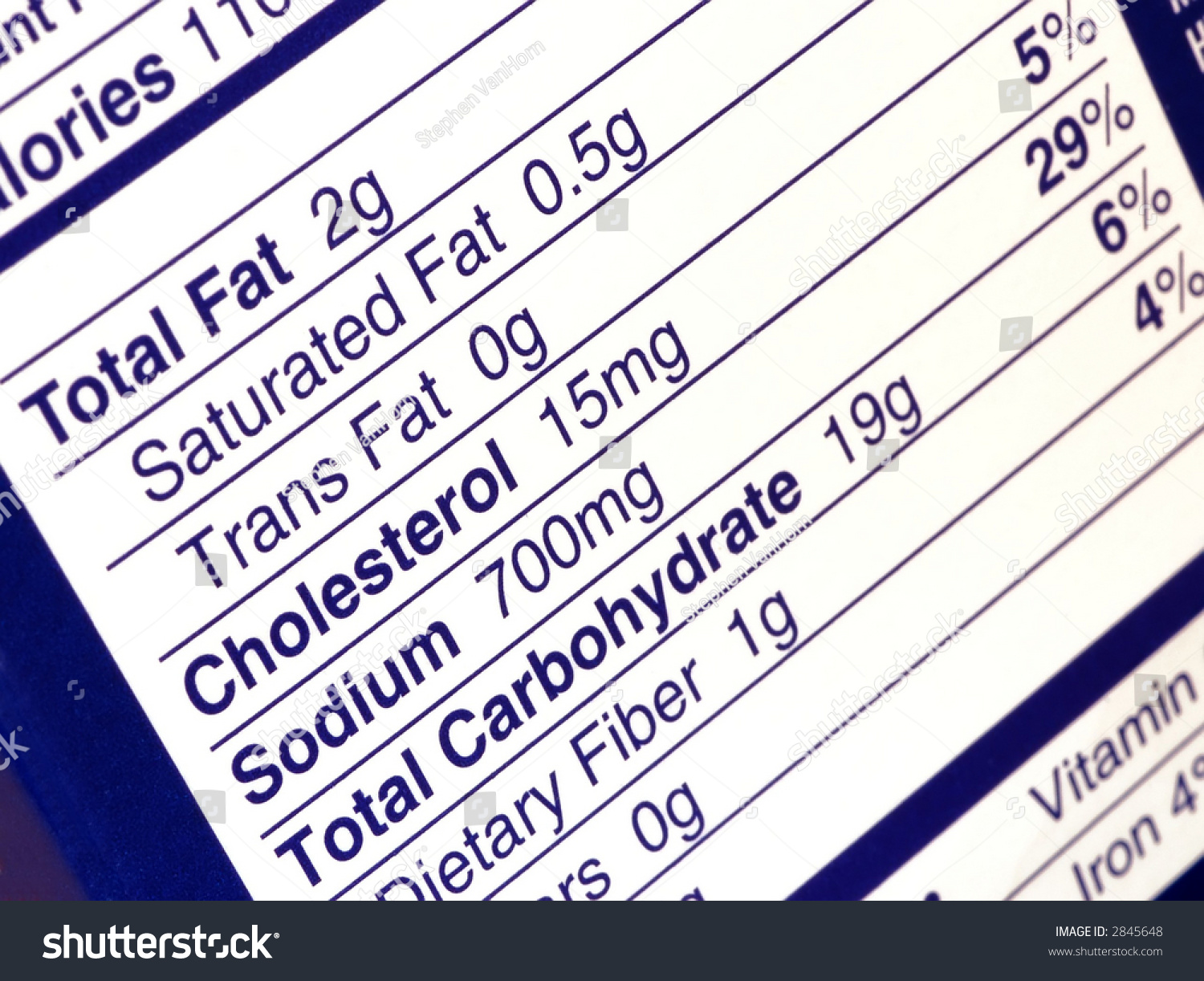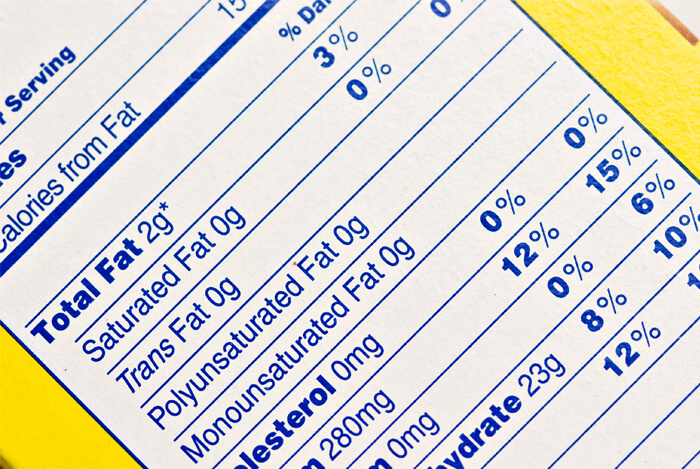39 total fat on nutrition labels
How to Read Nutrition Labels: Fat Content, Carbs & What To Look For Total Fat Nutrition labels are required to include total fat, saturated fat, and trans fat. The total amount of fat in the diet is a percentage of your calorie needs. The recommendation for the typical American diet is around 30%. For someone taking in 2,000 calories, this would mean around 70 grams of total fat per day. PDF Nutrition Facts Label: Total Fat Nutrition Facts Label: Total Fat Serving Size 1 package (272g)Total Fat Servings Per Container 1 Amount Per Serving Calories 300 Calories from Fat 45 % Daily Value* Total Fat 5g 8% Saturated Fat 1.5g 8% Trans Fat 0g Cholesterol 30mg 10% Sodium 430mg 18% Total Carbohydrate 55g 18% Dietary Fiber 6g 24% Sugars 23g
How to Read Nutrition Facts Labels the Right Way - GoodRx Nutrition Facts labels are required to list the total fat, saturated fat, and trans fats on packaged food products. It's important to choose foods with the right kinds of fats. Here are the differences between the fats you'll see on the label. Bad fats Saturated and trans fats are the less healthy types of fats.
Total fat on nutrition labels
Food Labels | CDC All the numbers on this label are for a 2/3-cup serving. This package has 8 servings. If you eat the whole thing, you are eating 8 times the amount of calories, carbs, fat, etc., shown on the label. Total Carbohydrate shows you types of carbs in the food, including sugar and fiber. Choose foods with more fiber, vitamins, and minerals. Decoding Nutrition Fact Labels: Fats | by Karena Yan - Medium The four main categories of fats delineated on most nutrition facts labels are saturated fat, polyunsaturated fat, monounsaturated fat, and trans fat. Of these, saturated fat and trans fat are ... Understanding Food Nutrition Labels | American Heart Association Remember that the information shown in the label is based on a diet of 2,000 calories a day. You may need less or more than 2,000 calories depending upon your age, gender, activity level, and whether you're trying to lose, gain or maintain your weight. When the Nutrition Facts label says a food contains "0 g" of trans fat, but includes ...
Total fat on nutrition labels. How to Read a Nutrition Label - WebMD Here's a label-reading shortcut. First, ignore the "sell" on the front. Go straight to the back and look at %DV. According to the FDA, you should look for nutrients you want, such as fiber, to ... Stop Worrying About Total Fat - Tufts Health & Nutrition Letter Since one gram of fat—regardless of the type of fat—contains about 9 calories, in a 2,000-calorie daily diet that advice translated to a maximum of 65 grams of fat per day. The 1980 recommendation was revised in the 2005 guidelines to a range of 20% to 35% of calories from total fat. Food Labels: Fat & Cholesterol | Home & Garden Information Center total fat—20 to 35% of calories, depending on age and gender (65 grams for the 2,000-calorie intake level used in the Daily Value)* saturated fat—less than 10% of calories** trans fat— keep as low as possible cholesterol—there is no longer a specific recommended limit for dietary cholesterol, but should be consumed as little as possible Interpreting Total Fat and Types of Fat on Food Labels - Nina Cherie ... Now, at the end of the day, since all high-fat foods tend to drive up calorie counts, it's typically recommended that you limit your intake of total fat to 25-35% of your daily calories. Of this amount, saturated fats and trans fats should comprise less than 7-10% and no more than 1%, respectively.
PDF How Do I Understand the "Nutrition Facts" Label? The Nutrition Facts label contains this information: • Serving size — tells you how much of the food is considered a "serving." A package may contain multiple ... • Total Fat — is the amount of fat found in one serving of the food. Total fat includes the amount of "bad fats" (saturated and trans) and "good fats ... This Is How to Read a Nutrition Facts Label on the Keto Diet This act mandated that, with a few exceptions, all packaged foods needed nutrition labels — thus creating the black-and-white labels we see on packaged foods today. The nutrients that required labeling included: Calories Calories from fat Total fat Saturated fat Cholesterol Sodium Total Carbohydrate Dietary fiber Sugars Protein Vitamin A Vitamin C Nutrition Labels for Healthy Weight Loss - Dr. Kellyann Use this section to understand if a product claims to be low-sodium or high in fiber. For instance, if you want to compare a non-fat product with a reduced-fat product, the percent daily value or total fat can easily be compared using the nutrition label. You'll be able to use this method when comparing various claims that a food is: Free Low ... Nutrition Facts Label: A guide on how to read them - NF Sports It works like this: the nutrition facts label will list total calories per serving size. Then in another place, the label will list calories from fat. These are not separate calories. If the label states 150 calories, and the calories from fat are listed as 50 calories, this simply means that the other calories come from sources like ...
Interactive Nutrition Facts Label - Food and Drug Administration Total Fat 4g 8% Saturated Fat 1.5g Trans Fat 0g 2% Cholesterol 5mg 19% Sodium 430mg 17% Total Carbohydrate 46g 25% Dietary Fiber 7g Total Sugars 4g 4% Includes 2g Added Sugars Protein 11g 10%... Nutrition Label Glossary: Definitions of Nutrition Fact Terms This number on a food label indicates how many grams of carbohydrates are in a single serving of a food. Total fat. This number on a food label indicates how much fat is in a single serving of a ... Learn How the Nutrition Facts Label Can Help You Improve Your Health Nutrients Required on Label Vitamin D and potassium values are required. Calcium and iron will continue to be required. Vitamins A and C will no longer be required but can be included on a voluntary basis. Slight Decrease in Sodium Allowance The daily limit for sodium decreased slightly from 2,400 mg per day to 2,300 mg per day. Fat Content on Food Labels - Reading Between the Lines When it comes to listing fat on food labels, manufacturers are required to only list total fat and saturated fat. Some also voluntarily list monounsaturated and polyunsaturated fat, but it's unlikely you'll see trans fat listed."
What Are the Fats Not Listed on Nutrition Labels? - SF Gate You should limit total fat to less than 25 to 35 percent of your total daily calories and keep saturated fat intake below 7 percent of your calories. Cholesterol intake should not exceed 300...
Daily Value on the New Nutrition and Supplement Facts Labels For example, the DV for total fat has been updated from 65g to 78g. That means that a packaged food with 36g of total fat in one serving (previously 55% DV) now has 46% DV. See below for a...
PDF What It Is - Food and Drug Administration For Monitoring Total Fat in Your Diet . Use the . Nutrition Facts . label as a tool for monitoring consumption of total fat. The Nutrition Facts label on packaged foods and beverages shows the amount in grams (g) and the % Daily Value (%DV) of total fat per serving of the food. The Nutrition Facts label also lists the types of fat that make up ...
Nutrition Facts Label: Total Fat - nlsd.org The Nutrition Facts Label also lists the types of fat that make up the total fat in a product. This includes the amount in grams (g) per serving of saturated fat and . trans. fat and the %DV of saturated fat. Food manufacturers may also . voluntarily. list the amount in grams (g) per serving of monounsaturated fat and polyunsaturated fat. The ...
How to Find the Percentage of Total Fat by Gram Weight on a Food Label Step 3: Convert to Percentage. The result from Step 2 is a percentage, but it's expressed in decimal form. To convert it to an easier-to-understand percentage, multiply it by 100: 0.3 × 100 = 30 percent. So 30 percent of the calories in this serving of salmon come from fat.
The Basics of the Nutrition Facts Label A food item with a 5% DV of fat provides 5% of the total fat that a person who needs 2,000 calories a day should eat. You may need more or less than 2,000 calories per day. This means that you may need more or less than 100% DV that is listed on the package for some nutrients. Low is 5% or less.
FDA Rounding Rules for Your Food Label - LabelCalc If your product has: Fewer than 5 calories per serving, round down to zero. 50 or fewer calories per serving, round to the nearest 5 increment (i.e. 42 rounds to 40). More than 50 calories per serving, round to the nearest 10 increment (i.e. 106 becomes 110). Calories from Fat, Total Fat, Saturated Fat, and Trans Fat.
How to Understand and Use the Nutrition Facts Label | FDA Nutrients to get less of: Saturated Fat, Sodium, and Added Sugars. Saturated fat, sodium, and added sugars are nutrients listed on the label that may be associated with adverse health effects - and...
Do Saturated Fats & Unsaturated Fats Equal Total Fats on Nutrition Labels? So, if a serving of your favorite cookies has 0.49g of transfat, saturated fat or unsaturated fat - just 0.01g away from the 0.5g threshold - the manufacturer can label it as containing 0g of that...
Nutrition Labels 101: What's Required? What's Optional? The FDA recommends using the AOAC Official Method of Analysis 996.06 to determine the total fat per serving. 4 If the total fat is less than 0.5 grams per serving, it can be expressed as zero on the nutrition label, but it still must be listed. 4. Saturated Fat "Saturated" fat is the sum of all fatty acids containing no double bonds.
Understanding Food Nutrition Labels | American Heart Association Remember that the information shown in the label is based on a diet of 2,000 calories a day. You may need less or more than 2,000 calories depending upon your age, gender, activity level, and whether you're trying to lose, gain or maintain your weight. When the Nutrition Facts label says a food contains "0 g" of trans fat, but includes ...
Decoding Nutrition Fact Labels: Fats | by Karena Yan - Medium The four main categories of fats delineated on most nutrition facts labels are saturated fat, polyunsaturated fat, monounsaturated fat, and trans fat. Of these, saturated fat and trans fat are ...
Food Labels | CDC All the numbers on this label are for a 2/3-cup serving. This package has 8 servings. If you eat the whole thing, you are eating 8 times the amount of calories, carbs, fat, etc., shown on the label. Total Carbohydrate shows you types of carbs in the food, including sugar and fiber. Choose foods with more fiber, vitamins, and minerals.















Post a Comment for "39 total fat on nutrition labels"